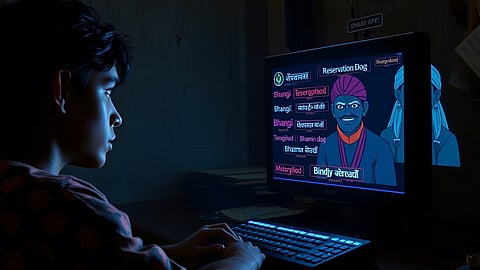

The caste system remains one of the most oppressive and dehumanizing social hierarchies ever created, deeply embedded in Indian society for over three millennia. Despite being constitutionally abolished, this brutal system continues to dictate economic opportunities, social interactions, and even digital behavior, reinforcing a vicious cycle of discrimination, exclusion, and psychological trauma. Far from being a relic of the past, caste actively shapes modern India, ensuring that privilege remains concentrated among upper castes while systematically crushing the aspirations of those at the bottom. Worse, in the age of the internet, caste prejudice has evolved, spreading its poison into online spaces where anonymity emboldens bigotry and amplifies the suffering of the oppressed.
The caste system was designed to enforce rigid occupational segregation, locking generations into hereditary roles—Brahmins as priests, Kshatriyas as rulers, Vaishyas as merchants, Shudras as laborers, and Dalits (formerly labeled "untouchables") as outcasts forced into degrading, dehumanizing work. Even today, this hierarchy dictates economic reality. Dalits remain grotesquely overrepresented in sanitation work, with 95% of manual scavengers coming from this community despite making up only 16% of India's population. Meanwhile, upper castes dominate corporate leadership, with a 2019 study revealing that 93% of Indian corporate board members belong to privileged castes. Entrepreneurship is another battleground of exclusion—systemic barriers prevent Dalits from accessing business networks, loans, and markets, resulting in less than 5% owning significant economic integration.
Land ownership, education, and capital accumulation have always been caste-driven, ensuring that wealth remains concentrated in the hands of a privileged few. A staggering 70% of India’s poorest citizens are Dalits and Adivasis(indigenous peoples), while upper castes continue to control disproportionate land and property. Reservation policies, meant to correct historical injustices, face hysterical opposition from privileged groups who decry "reverse discrimination" while ignoring centuries of inherited advantage. Even globalization, often hailed as a great equalizer, has disproportionately benefited upper castes—90% of Indian-origin Silicon Valley executives are Brahmins or other privileged castes, proving that caste privilege transcends borders.
In the labor market, caste determines earning potential with brutal efficiency. Dalit laborers earn 30-50% less than their upper-caste counterparts for the same work in rural areas, a glaring testament to entrenched discrimination. The corporate sector is no better—a 2020 study exposed how job applicants with Dalit or Muslim names received 33% fewer callbacks, revealing the quiet bigotry lurking beneath polished office floors. In urban informal sectors, lower castes are funneled into precarious gig economy jobs—delivery, construction, domestic work—where exploitation is rampant and social security nonexistent.
Generations of systemic oppression have conditioned lower castes to internalize their subjugation, manifesting in crippling self-doubt and social withdrawal. Many Dalits avoid upper-caste spaces—high-end restaurants, luxury stores, elite educational institutions—due to the ever-present fear of humiliation. Linguistic policing further reinforces exclusion, with lower-caste individuals mocked for speaking English or adopting "upper-caste" mannerisms, accused of "trying too hard." This psychological warfare extends into digital spaces, where many oppressed-caste users downplay their identity or avoid caste-related discussions altogether to evade harassment.
The internet, rather than being a liberating force, has become a new frontier for casteist abuse. Dalit activists, journalists, and even ordinary social media users face relentless casteist slurs—"reservation beggar," "dirty caste"—spewed by anonymous trolls who revel in their cruelty. Organized trolling campaigns systematically mass-report anti-caste voices, pushing them off platforms like Twitter and Facebook in a modern-day digital purge. Dating apps, which should foster connection, instead mirror real-world untouchability, with countless profiles boldly declaring "No Dalits" in their bios.
This humiliation is not confined to India—caste discrimination follows Indians across the globe. In Silicon Valley, Dalit tech workers report being excluded from promotions and social events, their contributions erased by the silent hand of caste bias. Diaspora communities in the UK and Canada replicate these hierarchies, with caste-based bullying forcing many to conceal their identities for survival. Online forums frequented by global Indians often devolve into cesspools of casteist mockery, where lower-caste accents, traditions, and struggles are ridiculed for the amusement of the privileged.
While anti-caste movements and affirmative action policies have made incremental progress, the psychological scars of caste-based inferiority run deep and continue to fester. Real change demands more than token gestures—it requires the strict enforcement of anti-caste laws (currently ignored as most caste crimes go unpunished), economic reparations in the form of land redistribution and equitable access to capital, and global recognition of caste discrimination as a serious issue, particularly in tech hubs like Silicon Valley. Digital solidarity is also crucial—calling out casteist trolls, platforming marginalized voices, and refusing to let bigotry hide behind anonymity.
The world must stop romanticizing India’s culture without confronting this darkest of realities—until caste is dismantled not just legally, but socially, economically, and digitally, millions will remain trapped in its cruel grip, their potential crushed under the weight of a system designed to keep them down.